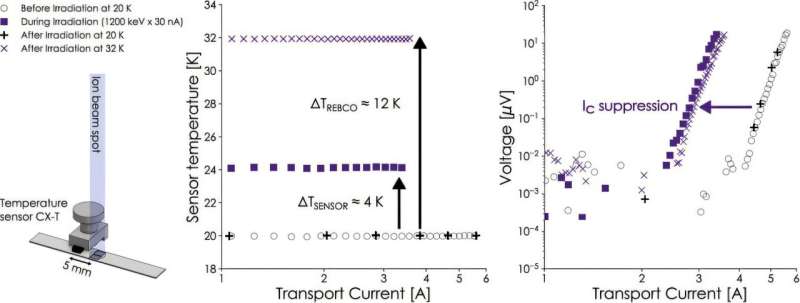High-temperature superconducting magnets made from REBCO, an acronym for rare-earth barium copper oxide, make it possible to create an intense magnetic field that can confine the extremely hot plasma needed for fusion reactions, which combine two hydrogen atoms to form an atom of helium, releasing a neutron in the process.
But some early tests suggested that neutron irradiation inside a fusion power plant might instantaneously suppress the superconducting magnets‘ ability to carry current without resistance (called critical current), potentially causing a reduction in the fusion power output.
Now, a series of experiments has clearly demonstrated that this instantaneous effect of neutron bombardment, known as the “beam on effect,” should not be an issue during reactor operation, thus clearing the path for projects such as the ARC fusion system being developed by MIT spinoff company Commonwealth Fusion Systems.
The findings were reported in the journal Superconductor Science and Technology, in a paper by MIT graduate student Alexis Devitre and professors Michael Short, Dennis Whyte, and Zachary Hartwig, along with six others.
“Nobody really knew if it would be a concern,” Short explains. He recalls looking at these early findings: “Our group thought, man, somebody should really look into this. But now, luckily, the result of the paper is: It’s conclusively not a concern.”
The possible issue first arose during some initial tests of the REBCO tapes planned for use in the ARC system. “I can remember the night when we first tried the experiment,” Devitre recalls. “We were all down in the accelerator lab, in the basement. It was a big shocker because suddenly the measurement we were looking at, the critical current, just went down by 30%” when it was measured under radiation conditions (approximating those of the fusion system), as opposed to when it was only measured after irradiation.
Before that, researchers had irradiated the REBCO tapes and then tested them afterward, Short says. “We had the idea to measure while irradiating, the way it would be when the reactor’s really on,” he says. “And then we observed this giant difference, and we thought, oh, this is a big deal. It’s a margin you’d want to know about if you’re designing a reactor.”
After a series of carefully calibrated tests, it turned out the drop in critical current was not caused by the irradiation at all, but was just an effect of temperature changes brought on by the proton beam used for the irradiation experiments. This is something that would not be a factor in an actual fusion plant, Short says.
“We repeated experiments ‘oh so many times’ and collected about a thousand data points,” Devitre says. They then went through a detailed statistical analysis to show that the effects were exactly the same, under conditions where the material was just heated as when it was both heated and irradiated.
This excluded the possibility that the instantaneous suppression of the critical current had anything to do with the “beam on effect,” at least within the sensitivity of their tests. “Our experiments are quite sensitive,” Short says. “We can never say there’s no effect, but we can say that there’s no important effect.”
To carry out these tests required building a special facility for the purpose. Only a few such facilities exist in the world. “They’re all custom builds, and without this, we wouldn’t have been able to find out the answer,” he says.
The finding that this specific issue is not a concern for the design of fusion plants “illustrates the power of negative results. If you can conclusively prove that something doesn’t happen, you can stop scientists from wasting their time hunting for something that doesn’t exist.”
And in this case, Short says, “You can tell the fusion companies: ‘You might have thought this effect would be real, but we’ve proven that it’s not, and you can ignore it in your designs.’ So that’s one more risk retired.”
That could be a relief to not only Commonwealth Fusion Systems but also several other companies that are also pursuing fusion plant designs, Devitre says. “There’s a bunch. And it’s not just fusion companies,” he adds. There remains the important issue of longer-term degradation of the REBCO that would occur over years or decades, which the group is presently investigating.
Others are pursuing the use of these magnets for satellite thrusters and particle accelerators to study subatomic physics, where the effect could also have been a concern. For all these uses, “this is now one less thing to be concerned about,” Devitre says.
More information:
A R Devitre et al, Beam heating explains critical current suppression measured during ion irradiation of REBCO tapes, Superconductor Science and Technology (2024). DOI: 10.1088/1361-6668/ad95c2
Provided by
Massachusetts Institute of Technology
This story is republished courtesy of MIT News (web.mit.edu/newsoffice/), a popular site that covers news about MIT research, innovation and teaching.
Citation:
Will neutrons compromise the operation of superconducting magnets in a fusion plant? (2025, February 28)
retrieved 28 February 2025
from https://phys.org/news/2025-02-neutrons-compromise-superconducting-magnets-fusion.html
This document is subject to copyright. Apart from any fair dealing for the purpose of private study or research, no
part may be reproduced without the written permission. The content is provided for information purposes only.

